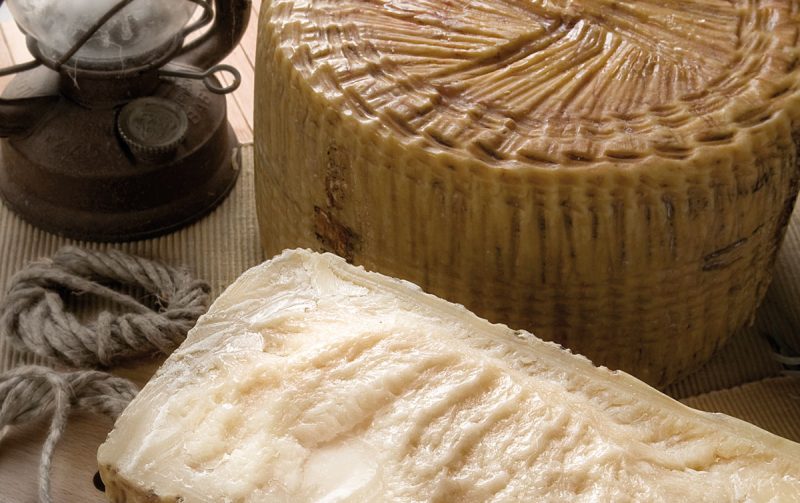canestrato
Product included in the national list of traditional agri-food products (PAT)
PAT type: Cheeses
Production area: Sicily
It has ancient origins. It appears already in 1400 in gabelle contracts. It was used by the gabellotto to pay the rent of the land. In 1407 it was called "tumazza". In 1412 "cacio vacchino". In 1562 it was the "nectar" of the nuns of San Castrenze.
Technical data sheet of the traditional agri-food product (PAT)
Historical equipment: Wooden vat, tinned copper boiler, wooden thorn or wheel, wooden cisca, “fascedde” rush baskets, wooden boards. Direct wood-gas fire.
Maturing rooms: They are very fresh and ventilated traditional environments in which the shapes are placed on wooden shelves. There are also natural cellars and caves with geologically natural walls.
Recurring names deriving from different stages of salting / maturing: Fresh tuma without any salting. Primosale indicates a fresh cheese of about 8-10 days that has undergone external dry salting. Secondosale indicates a semi-matured cheese of about 2-4 months that has undergone dry salting.
Aged indicates a cheese, salted in the same way, whose maturation exceeds 4 months.
Brief historical notes: The typical canestrato cheese also known as "vacchino" is mentioned in gabelle contracts since the 1400s as one of the products to be delivered annually to the gabellotto as a rental price for the large estate. This cheese also appears in 1407 in the dairy products list as "tumazza".
Trasselli still finds it in a 1412 calmiere under the heading "cacio vacchino" to be sold at a lower price "4 vs 5 roll grains" compared to the Palermo caciocavallo. It is still mentioned in the diet of the nuns of the monastery of San Castrenze in 1562.
Type: Hard, semi-cooked cheese.
Production: Whole Sicilian territory.
Main production technology lines:
species / breed: Cow and sometimes sheep and / or goat;
raw material: Cow's milk sometimes mixed with sheep's and / or whole goat's milk, raw;
microflora: Natural;
rennet: Lamb or kid pasta;
prevailing power supply system: Natural and cultivated pasture with integration of fodder and concentrates in the stable;
processing techniques: The canestrato is produced with traditional techniques using ancient tools. The milk coagulates in a wooden vat at 35 ° C with lamb rennet paste. The curd is drained by hand after being placed in "fascere" rush baskets which leave a particular molding on the surface of the cheese. When canned, black peppercorns or chilli flakes can be added. The curd is seared at about 80 ° C and placed on wooden boards. The next day it is salted;
salting: After the purging and acidification phase, the cheese is extracted from the baskets and dry salted with fine sea salt, taking care to create a layer of compact salt on the cheese.
The quantity of salt varies according to the characteristics of the product and is not easily quantifiable;
seasoning: 8-10 days (fresh), 2-4 (semi-cured), over 4 months (cured).
Product features: Finished
Historical references:
Homer: "Odyssey" (9th book), 1950th-XNUMXth century. BC, Onorato Castellino – Vincenzo Peloso, Graphic Workshops XNUMX.
Virgil: "Bucolics and Georgics" (Eclogue V and book 3), 37-30 BC / 42-39 BC, Lorenzo Giudice, 1954.
Notary Guglielmo Mazzapiedi, 5th November 1421th century, ind. 839; state archive of Palermo, vol. XNUMX, f.
103.
Notary Luca Cuccia, 25 August XIV century, ind. 1601; State Archives of Palermo, V. st. vol. 1022, f. 485 See the municipal archive of Palermo, vol. 22 n. 44; Dairy Calmiere - December 5, 1407.
Municipal Archive of Palermo, vol. 23 n. 2; Calmiere imposed by the jurors and arbitrators for retail sale in the markets - March 21, 1412.
Carmelo Trasselli: "Calmiere of retail supplies in Palermo", 1412-1440 from the municipal archive of Palermo.
Campisi Carmelo "Sheep and pecorino of Sicily", Francesco Battiato Editore, Catania, 1933.
Archiepiscopal Archive of Monreale, Pitazzi and Visit to the Monastery of Corleone, vol. 6, 1578.
Carmelo Trasselli: "Some Calmieri Palermo of the '400, extracted from: Economia e storia, Italian magazine of economic and social history, 1968, fasc. 3.
Relief from the University of Mezzojuso (appendix no.5) quoted in Ignazio Gattuso: “Economy and society in a rural town in Sicily; XVI-XIX centuries ". Tumminelli Editore - Palermo.
Archive of the Collegiate Churches of Monreale, vol. SCA 1 bis.
Vizzardi-Maffeis "Italian cheeses", Agricultural editions, Bologna, 1990.
National Institute of Rural Sociology: "Atlas of typical products: cheeses", Franco Angeli, Milan, 1990.
CNR: “The dairy products of the South”, 1992.
Ministry of Agriculture and Forestry: "Italian DOC cheeses" published by UNALAT in collaboration with INSOR, Franco Angeli, Milan, 1992.
Source Pat Cards: Sicily Region
Card insertion: Ignazio Caloggero
Information contributions: Web, Region of Sicily
Note: The population of the cards of the Heritage database proceeds in incremental phases: cataloging, georeferencing, insertion of information and images. The cultural property in question has been cataloged, and the first information has been entered. In order to enrich the information content, further contributions are welcome, if you wish you can contribute through our area "Your Contributions"




